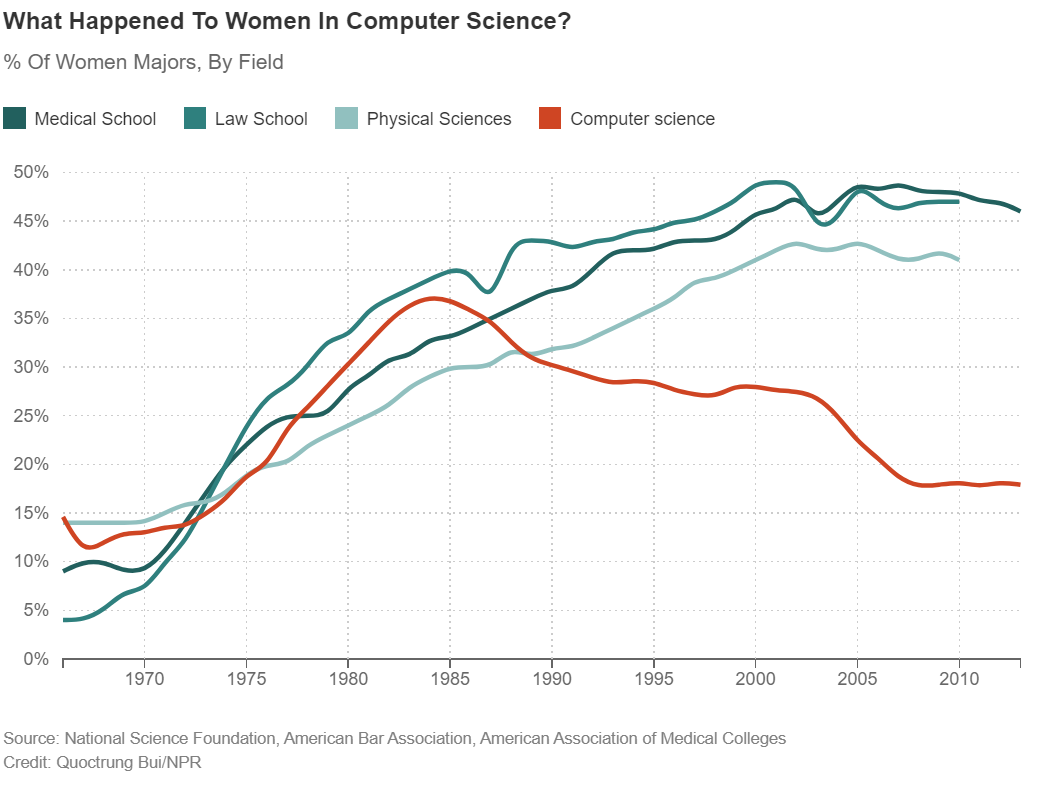Programming, Gender, Status, and Money
Contents
19.6. Programming, Gender, Status, and Money#
While we’ve been talking about capitalism and social media platforms, we also want to look at the world of programming as well. In particular, we want to highlight how the profession of programming went from being a disrespected, low-pay job for women, to being a highly respected and high paying job for men.
19.6.1. Programming as Women’s Work#
As you may have noticed in chapter 2 of the book, the first programmers were almost all women. When computers were being invented, men put themselves in charge of building the physical devices (hardware), and then gave the work of programming the computer (software) to their assistants, often women. So, for example, you can see this at various stages of computer development, such as:
1800s: Charles Babbage describes the first full computer (Analytical Engine), and Ada Lovelace writes down the first computer program for it.
1945: The first general-purpose electrical computer was created by men and programmed by women
1950s: Grace Hopper invents the compiler to help with programming the computers (built by men)
As women were advancing the field of computer programming, some of them became frustrated with how they were viewed, such as Margaret Hamilton:

Fig. 19.2 Photo of Margaret Hamilton next to the computer program source code (which she was in charge of) for the Apollo missions to the moon.#
When Margaret Hamilton was in charge of creating the software to run on the Apollo rockets, the men around her considered programming to be easy and less serious than the “engineering” they were doing in building the rocket. So, she began calling the programming she was doing “software engineering” to convey the complexity and rigor of the work she and her team were doing. She was able to convince her colleagues and the term “software engineering” became common.
Still, up through the 1960s and 1970s, most computer companies made their money by selling the physical hardware. They happened to include some software to go with it, and people who bought the hardware would sometimes hire people to make more software. So software was still considered secondary, and up until the early 1980s, women were getting around 37% of computer science degrees.

Fig. 19.3 Graph showing percentage of women receiving degrees in different fields from NPR.#
19.6.2. Programming for Boys and Men#
In the early 1980s, a number of things changed which ended up with programming seen as a male profession, and a highly profitable and respected one.
One of the changes was that some men in the computer business figured out how to make money selling software. This was particularly the case for Bill Gates who convinced companies like IBM to license his software, so he could continue making money as more people used it.
Another change was that as computers became small enough for people to buy them for their homes, they became seen as toys for boys and not girls. The same transition is seen in video game consoles from being for the whole family to being for boys only (e.g., the Nintendo Game Boy). In the end, computer programming became profitable and male-dominated.
As many are trying to get women into programming, so that they aren’t cut out of profitable and important fields, Amy Nguyen warns that men might just decide that programming is low status again (as has happened before in many fields):
The history of women in the workplace always tells the same story: women enter a male-dominated profession, only to find that it’s no longer a respectable field. Because they’re a part of it, so men leave in droves. Because women do it, and therefore it must not be important. Because society would rather discredit an entire profession than acknowledge that a female-dominated field might be doing something that actually matters.
19.6.3. See Also#
Twitter threads on women in professions
